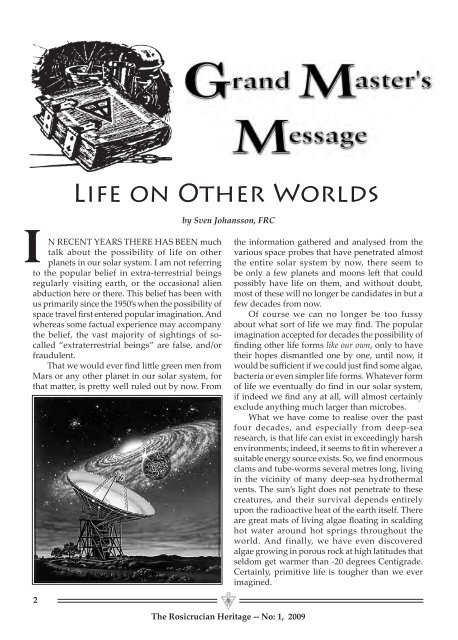Rosicrucian Heritage Magazine - 2009-03 - AMORC
Rosicrucian Heritage Magazine - 2009-03 - AMORC
Rosicrucian Heritage Magazine - 2009-03 - AMORC
You also want an ePaper? Increase the reach of your titles
YUMPU automatically turns print PDFs into web optimized ePapers that Google loves.
In recent years there has been much<br />
talk about the possibility of life on other<br />
planets in our solar system. I am not referring<br />
to the popular belief in extra-terrestrial beings<br />
regularly visiting earth, or the occasional alien<br />
abduction here or there. This belief has been with<br />
us primarily since the 1950’s when the possibility of<br />
space travel first entered popular imagination. And<br />
whereas some factual experience may accompany<br />
the belief, the vast majority of sightings of socalled<br />
“extraterrestrial beings” are false, and/or<br />
fraudulent.<br />
That we would ever find little green men from<br />
Mars or any other planet in our solar system, for<br />
that matter, is pretty well ruled out by now. From<br />
2<br />
Life on Other Worlds<br />
by Sven Johansson, FRC<br />
The <strong>Rosicrucian</strong> <strong>Heritage</strong> -- No: 1, <strong>2009</strong><br />
the information gathered and analysed from the<br />
various space probes that have penetrated almost<br />
the entire solar system by now, there seem to<br />
be only a few planets and moons left that could<br />
possibly have life on them, and without doubt,<br />
most of these will no longer be candidates in but a<br />
few decades from now.<br />
Of course we can no longer be too fussy<br />
about what sort of life we may find. The popular<br />
imagination accepted for decades the possibility of<br />
finding other life forms like our own, only to have<br />
their hopes dismantled one by one, until now, it<br />
would be sufficient if we could just find some algae,<br />
bacteria or even simpler life forms. Whatever form<br />
of life we eventually do find in our solar system,<br />
if indeed we find any at all, will almost certainly<br />
exclude anything much larger than microbes.<br />
What we have come to realise over the past<br />
four decades, and especially from deep-sea<br />
research, is that life can exist in exceedingly harsh<br />
environments; indeed, it seems to fit in wherever a<br />
suitable energy source exists. So, we find enormous<br />
clams and tube-worms several metres long, living<br />
in the vicinity of many deep-sea hydrothermal<br />
vents. The sun’s light does not penetrate to these<br />
creatures, and their survival depends entirely<br />
upon the radioactive heat of the earth itself. There<br />
are great mats of living algae floating in scalding<br />
hot water around hot springs throughout the<br />
world. And finally, we have even discovered<br />
algae growing in porous rock at high latitudes that<br />
seldom get warmer than -20 degrees Centigrade.<br />
Certainly, primitive life is tougher than we ever<br />
imagined.












